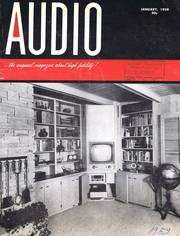Erläuterungen zu diesen US-AUDIO Seiten der 1950er Jahre
Die hier stehenden amerikanischen Artikel aus 1959 (aus der US-AUDIO) sind teilweise sehr gewöhnungsbedürftig, weil sie erstens aus einer längst vergangenen Zeit stammen und zweitens, weil dort in den USA ganz "anders" gedacht wurde als bei uns in Old Germany oder in Europa.
Vergleichbar mit unseren deutschen Hifi-Magazinen etwa ab 1962 ist jedoch, daß auch dieses Audio-Magazin ihre Anzeigen- Kunden und -Leser am Markt oder von anderen Magazinen (be- oder ab- ?) werben mußte. - Weiterhin sind die riesigen Dimensionen des amerikanischen Kontinents mit unseren hier in Europa nicht vergleichbar. - Ein Redaktions-"Trip" von New York nach Los Angeles oder Chicago oder gar in die Wüste nach Las-Vegas zu einer der CES- Audio- "Shows" war - auch mit dem Flugzeug - immer noch eine halbe Weltreise. Und jede Ausstellung oder "Messe" wurde als "Show" deklariert. Und natürlich, in USA musste alles "Show" sein, um beim Publikum einige Aufmerksamkeit zu erzeugen.
.
Die monatliche Kolumne - Editors' REVIEW - das Editorial
"RECORDING PERSPECTIVE"
During one of the habitual talk-fests commonly engaged in by those interested in the art of sound reproduction, the question came up about the perspective in which a particular recording was made. And with it, came the discussion about how recordings made with different perspectives will sound in various rooms.
Now it is fairly well known in the sound movie business that the sound must appear to be creditable to the scene which accompanies it.
Ein paar Beispiele
For example, an intimate two-shot must have a close-up quality to it, completely free of any "room sound" - which is another name for reverberation.
Similarly, an orator (Redner) on the rostrum (Podium) in a large hall must sound as though he were actually there - even if the camera moves in for a close-up, there should be some room sound remaining.
Sound picture engineers, directors, and producers have become so accustomed to these requirements that it is rare that you hear a sound which is not in keeping with the picture.
Eine Ausnahme (im Kino oder Fernsehen)
The one exception is likely to be the case where the camera alternates between long-shots, medium-shots, and close-ups on a singer performing on a stage. Here, in order to keep the singing voice consistent throughout, the sound quality is usually a compromise, and does not change from one camera position to another.
Bei Orchesteraufnahmen
In orchestral recordings, in contrast, there is no picture to guide the listener. However, when one pays close attention to the amount and type of reverberation, he should be able to approximate the microphone positions, particularly with monophonic recordings.
Some orchestras are microphoned so that they sound as though they were in a large hall, and the listener seems to be back about 25 rows. A prime example of this type of recording can be heard in practically any number by the Pittsburgh orchestra under Steinberg.
The opposite of this gives the impression that the microphones are distributed throughout the orchestra, at no time more than a foot or so from the instruments, and most of the discs from the Westminister Laboratory series are in this group.
Und dann das Hören der Aufnahmen zuhause
In the distant microphoning, the dynamic range is reduced by the "flywheel" effect of the large hall; in the close-up technique, the dynamic range is high. As we see it, therefore, this means that in the home, the distant type of microphoning can be listened to comfortably in a small room, since the reverberation of the performing location is added to that of the listening room, and in this case the reverberation of the hall is sufficient in itself.
However, with the close-up technique, listening in a small room gives the impression of being crowded amongst the musicians. On the other hand, if the listening room is larger, one gets the impression of being on the stage with the orchestra, yet not being crowded.
Die richtigen Platten auswählen
Short of providing some reverberation device in the home, there is very little that can be done about this problem - except to be careful to choose records suited to his particular listening conditions.
We have always felt that the close-up quality, such as that of the Westminster Lab series, was interesting, because we do not hold that it is necessary to be transported into the 25th row of some auditorium to hear our music.
If the nearness of the performance makes it more interesting to the listener, that is what he should have. But we realize that in most instances we have listened to the Lab records in a rather larger listening room than usual, and that furthermore, we usually have several speakers throughout the house playing simultaneously, giving an increased reverberation, in effect, in the listening area.
Makes an interesting experiment, though. Just try listening to extremes of reverberations in both large and very small rooms. Should provide the subject for a whole evening's experimentation - and enlightenment.
And that is practically our last word for this year, except that.


